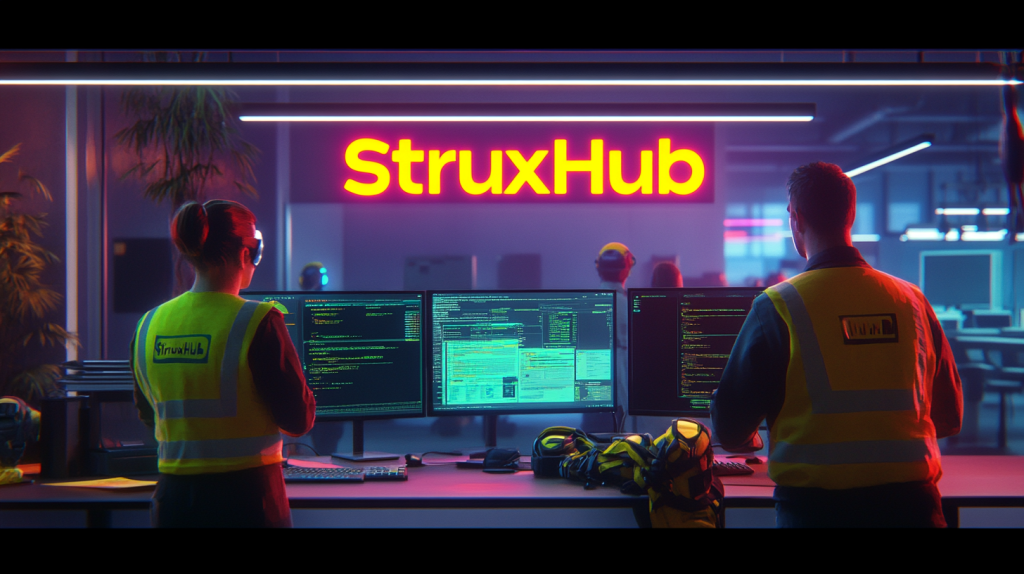Best Guide to Construction Management Software
Table of Contents:

What is Construction Management Software?
Construction management software is a powerful, integrated platform designed to help construction professionals plan, manage, and execute projects more efficiently. The construction industry is notoriously complex, involving numerous stakeholders, multiple phases, and countless moving parts that must be meticulously coordinated. This software offers a centralized solution to streamline every aspect of project management, making it an indispensable tool in today’s fast-paced construction environment.
Why You Need Construction Management Software Now More Than Ever
Traditional construction project management often relies on a patchwork of tools and manual processes that can lead to inefficiencies, errors, and costly delays. In contrast, construction management software integrates all facets of project management into one unified platform. From planning and scheduling to budgeting, resource management, document control, and risk management, this software provides a comprehensive solution that helps you keep everything on track.
Key Benefits of Construction Management Software:
- Centralized Project Management: Bring all your project data and processes under one roof.
- Real-Time Collaboration: Keep everyone on the same page with real-time updates and shared access.
- Improved Efficiency: Eliminate redundant tasks and streamline workflows to save time and resources.
- Better Decision-Making: Use data-driven insights to make informed decisions and optimize project outcomes.
How Construction Management Software Enhances Efficiency and Coordination
One of the standout features of construction management software is its ability to boost efficiency and improve coordination across all project phases. By acting as a single source of truth, the software eliminates information silos and provides team members with the data they need, exactly when they need it. Imagine a construction site where every team member knows exactly what’s happening, when, and why—that’s the power of real-time coordination.
Top Features That Boost Efficiency:
- Task Automation: Automate repetitive tasks to free up your team for more important work.
- Integrated Scheduling: Align your schedules seamlessly with other project elements to avoid conflicts.
- Resource Optimization: Allocate resources smartly to avoid bottlenecks and maximize productivity.
Streamlining Communication with Construction Management Software
Clear communication is the backbone of any successful construction project. Construction management software facilitates seamless communication among all stakeholders, from project managers to contractors, subcontractors, and clients. Integrated messaging, document sharing, and real-time notifications ensure that everyone is informed and working towards the same goals, minimizing misunderstandings and reducing the risk of errors.
How the Software Improves Communication:
- Integrated Messaging: Communicate directly within the platform to keep all project conversations in one place.
- Document Sharing: Share plans, permits, and other documents quickly and securely.
- Real-Time Notifications: Get instant alerts about project updates, changes, or issues.

Enhancing Document Management and Ensuring Compliance
Keeping track of documents like contracts, plans, and permits can be a logistical nightmare, but construction management software simplifies this process with a centralized and secure repository. It ensures that all documents are up-to-date, easily accessible, and properly organized. Plus, features like version control and audit trails enhance accountability, while compliance tracking helps ensure your project meets industry regulations and standards.
Key Document Management Features:
- Centralized Storage: Keep all your documents in one easily accessible location.
- Version Control: Manage document versions to ensure everyone is working with the latest information.
- Compliance Tracking: Stay compliant with industry standards and regulations through automated tracking and alerts.
Proactively Managing Risks and Ensuring Safety on the Jobsite
Risk management is a critical component of construction management, and the right software can help you stay ahead of potential issues. By identifying risks early and providing tools for developing mitigation strategies, construction management software helps keep your project on track and your workforce safe. Features like safety checklists, incident reporting, and compliance tracking are integral to maintaining a safe work environment and ensuring that your project adheres to regulatory requirements.
Safety and Risk Management Tools:
- Risk Identification: Spot potential risks early with built-in risk assessment tools.
- Safety Checklists: Use detailed checklists to ensure all safety protocols are followed.
- Incident Reporting: Quickly log and address safety incidents to prevent future occurrences.

Contact StruxHub
Try StruxHub today and see how it can transform your construction operations, making your job easier and more efficient.
Achieving High-Quality Standards with Construction Management Software
Maintaining high standards of quality is non-negotiable in construction, and construction management software plays a key role in this aspect. With tools for regular inspections, detailed checklists, and compliance tracking, the software helps ensure that your project meets all required quality standards. By addressing quality issues promptly, you can avoid costly rework and keep your clients happy.
Quality Control Features:
- Inspection Management: Schedule and track inspections to maintain high standards.
- Quality Checklists: Use pre-built checklists to ensure all aspects of the project meet quality benchmarks.
- Issue Tracking: Identify and resolve quality issues quickly to avoid delays.
Staying Connected with Mobile Access and Real-Time Updates
In today’s construction landscape, mobility is more important than ever. Construction management software offers robust mobile access, allowing project managers and field teams to stay connected and productive from anywhere. Real-time updates and mobile-friendly interfaces ensure that your team can access the latest project data, manage tasks, and collaborate effectively, even when they are on-site.
Mobile Features to Keep You Connected:
- Mobile Dashboards: Access key project metrics on the go with mobile-optimized dashboards.
- Task Management: Update tasks and schedules from your mobile device.
- Field Data Capture: Collect data directly from the field to keep your records up-to-date.
Integrating Construction Management Software with Other Tools
Integration capabilities are another significant advantage of construction management software. By integrating with other essential tools and systems, such as accounting software, CRM systems, and scheduling tools, the software ensures seamless data flow and enhances overall project efficiency. This interoperability reduces the need for manual data entry and helps maintain data accuracy and consistency across the organization.
Key Integrations to Look For:
- Accounting Software: Sync your financial data with popular accounting platforms for streamlined budgeting and reporting.
- CRM Integration: Keep client information and project data in sync for better customer service.
- Scheduling Tools: Integrate with advanced scheduling tools to optimize project timelines.
Maximizing Benefits with Comprehensive Training and Support
To truly reap the benefits of construction management software, comprehensive training and support are essential. Providers like StruxHub offer extensive training resources and dedicated support services to ensure that users can effectively utilize all the features of the software. Regular training sessions, a comprehensive knowledge base, and responsive support teams help users navigate the software confidently and address any issues promptly.
Training and Support Services:
- Onboarding Programs: Get your team up to speed quickly with structured onboarding programs.
- Ongoing Training: Keep skills sharp with regular training updates and new feature introductions.
- 24/7 Support: Access dedicated support when you need it, so you’re never left in the dark.
Comprehensive Features of StruxHub Construction Management Software
StruxHub’s construction management software is designed to address every aspect of project management, providing a seamless and integrated solution for the construction industry. Our software encompasses a wide range of features that ensure projects are planned, executed, and completed efficiently.
Top 20 Essential Construction Management Software Categories:

Construction Project Planning
Overview of Project Planning Tools and Techniques in Construction Management Software
Effective project planning is essential for the success of construction projects. Construction management software, such as StruxHub, provides various tools to streamline the planning process. These include Gantt charts, task lists, and resource allocation features. These tools help project managers define clear objectives, set milestones, and assign tasks efficiently, ensuring projects stay on track.

Construction Project Planning
Explore how StruxHub can simplify your construction project planning—reach out today and see how we can help you take control of your projects from start to finish
Key Features:
- Task Management: Organize and delegate tasks to team members to enhance productivity and accountability.
- Gantt Charts: Visualize project timelines and track progress against milestones.
- Resource Allocation: Allocate resources optimally to avoid bottlenecks and ensure smooth project execution.
- Collaboration Tools: Facilitate communication and collaboration among team members with integrated messaging and file sharing.
- Time Tracking: Monitor the time spent on each task to improve efficiency and accountability.
Gantt charts are particularly useful for providing a visual timeline of the project, illustrating the start and end dates of individual tasks as well as their dependencies. This visualization helps project managers anticipate potential delays and adjust the schedule proactively. Task lists, on the other hand, break down the project into smaller, manageable parts, making it easier to assign responsibilities and track progress.
Resource allocation tools ensure that all necessary resources—such as labor, equipment, and materials—are available when needed, thereby preventing delays caused by resource shortages. Collaboration tools enhance communication among team members, allowing for seamless sharing of information and real-time updates. Lastly, time tracking features enable project managers to monitor how much time is being spent on each task, helping identify areas where efficiency can be improved. These integrated tools collectively contribute to a more organized, efficient, and successful project planning process.
Best Practices:
- Define Clear Objectives: Establish specific, measurable goals for each phase of the project to maintain focus and direction.
- Use Templates: Utilize pre-built templates to standardize planning processes and save time.
- Regular Updates: Update the project plan regularly to reflect changes and progress, ensuring all stakeholders are informed.
- Risk Management: Identify potential risks early and develop mitigation strategies to avoid project delays and cost overruns.
- Feedback Loops: Implement feedback loops to gather input from team members and stakeholders, improving project plans over time.
- Resource Planning: Allocate resources effectively, considering their availability and project requirements.
- Milestone Setting: Set clear milestones to track progress and maintain project momentum.
- Documentation: Maintain thorough documentation of all planning activities to ensure transparency and accountability.
Related Topic Articles:
Mastering Project Planning in Construction Management: Essential Tools and Techniques
A detailed guide on the essential tools and techniques for effective project planning in construction management, including how to set clear objectives, allocate resources, and manage timelines.
Streamlining Construction Projects: The Ultimate Guide to Project Planning with StruxHub
Discover how StruxHub’s project planning features can streamline your construction projects, ensuring efficiency and successful project execution from start to finish.
From Blueprint to Building: Comprehensive Project Planning Strategies in Construction Management
Explore comprehensive strategies for project planning in construction management, focusing on the critical steps from initial blueprints to final construction, and how to ensure project success.
For a deeper dive into related topics, explore our sections on Scheduling and Resource Management. Discover how StruxHub enhances project planning with advanced tools designed for efficiency and accuracy.
Construction Scheduling
Detailed Guide on Scheduling Features and Best Practices in Construction Management Software

Construction Scheduling
Experience how StruxHub can simplify your construction scheduling—reach out today and find out how we can help you keep your projects on time and organized.
Scheduling is a critical component of construction management, ensuring that all tasks are completed on time and within budget. Construction management software, including StruxHub, offers advanced scheduling features such as the critical path method (CPM), task dependencies, and automatic notifications to keep everyone on track.
Key Features:
- Task Dependencies: Manage the relationships between tasks to ensure smooth progress and avoid delays.
- Automatic Notifications: Keep all stakeholders informed of schedule changes and updates automatically.
- Integration with Other Tools: Sync schedules with other project management tools for cohesive project oversight.
- Milestone Tracking: Set and track key project milestones to monitor progress and ensure timely completion.
- Resource Scheduling: Allocate resources efficiently to ensure that they are available when needed and avoid conflicts.
- Critical Path Method (CPM): Identify the sequence of critical tasks that determine the project duration and focus efforts on these tasks.
Effective scheduling in construction management involves not just planning tasks but ensuring that all elements of the project are synchronized. Task dependencies help in mapping out the sequence of operations, ensuring that each task starts and finishes in a manner that supports subsequent activities. Automatic notifications keep all team members updated on any changes, ensuring everyone is aligned with the project timeline.
Integration with other tools allows for seamless data flow across different project management platforms, ensuring that scheduling data is consistent and accessible. Milestone tracking is crucial for monitoring key phases of the project, providing checkpoints that help in assessing progress and identifying potential delays early. Resource scheduling ensures that the right resources are available at the right time, avoiding conflicts and ensuring efficient utilization.
Using CPM, project managers can focus on the tasks that directly impact the project’s completion date, optimizing efforts to keep the project on schedule. These features collectively contribute to a more organized, efficient, and successful scheduling process, ensuring that construction projects are completed on time and within budget.
Best Practices:
- Prioritize Tasks: Focus on critical tasks that have the highest impact on project timelines to maintain progress.
- Monitor Progress: Regularly review and adjust schedules based on actual progress to stay on track.
- Communicate Changes: Ensure all team members are aware of any schedule adjustments to maintain alignment.
- Use Baselines: Establish baselines to compare actual progress against planned progress, identifying deviations early.
- Schedule Reviews: Conduct regular schedule reviews with the team to ensure everyone is aligned and aware of upcoming tasks.
- Adjust for Delays: Anticipate potential delays and adjust the schedule proactively to mitigate their impact.
- Resource Availability: Ensure resource availability aligns with the scheduled tasks to prevent bottlenecks.
- Feedback Incorporation: Gather feedback from team members to improve scheduling accuracy and efficiency.
Related Topic Articles:
Proven Construction Scheduling Techniques and Best Practices for On-Time Project Delivery
Discover how to implement proven construction scheduling techniques and best practices to ensure your projects are delivered on time and within budget, maximizing efficiency and client satisfaction.
How Advanced Scheduling Tools Can Transform Your Construction Projects: Insights and Strategies from StruxHub
Learn how advanced scheduling tools, like those from StruxHub, can revolutionize your construction projects by improving coordination, reducing delays, and boosting overall project success.
The Comprehensive Guide to Mastering Construction Scheduling for Project Managers: Top Tools and Methods
Explore a comprehensive guide designed for project managers to master construction scheduling, featuring essential tools, methods, and real-world examples to keep your projects on track and ensure successful outcomes.
For additional insights, check out Project Planning and Resource Management. StruxHub’s scheduling tools offer seamless integration and advanced scheduling capabilities to enhance your construction projects.
Budgeting in Construction
Insights into Budgeting Tools and Financial Management in Construction Management Software

Budgeting in Construction
See how StruxHub can streamline your construction budgeting—contact us today to learn how we can help you stay on budget and control project costs effectively.
Budgeting is a crucial aspect of construction management, ensuring that projects stay within financial limits. Construction management software, like StruxHub, provides comprehensive budgeting tools, including cost estimation, expense tracking, and financial reporting.
Key Features:
- Cost Estimation: Predict and plan project costs accurately using historical data and market trends.
- Expense Tracking: Monitor and control project expenses in real-time to prevent budget overruns.
- Financial Reporting: Generate detailed financial reports to keep stakeholders informed about the financial health of the project.
- Cash Flow Management: Track cash flow to ensure the project has sufficient funds to continue smoothly.
- Budget Forecasting: Use forecasting tools to predict future budget needs based on current spending and project progress.
- Expense Categorization: Categorize expenses to identify areas of high expenditure and potential savings.
Effective budgeting in construction management involves not only predicting and planning project costs but also actively monitoring and controlling expenses throughout the project lifecycle. Cost estimation tools utilize historical data and market trends to provide accurate predictions, helping to set realistic budgets from the outset. Real-time expense tracking allows project managers to monitor spending closely, ensuring that any deviations from the budget are identified and addressed promptly.
Financial reporting features generate detailed reports that provide stakeholders with a clear view of the project’s financial status, fostering transparency and informed decision-making. Cash flow management tools track the inflow and outflow of funds, ensuring that the project remains financially stable and can proceed without interruptions.
Budget forecasting tools are essential for anticipating future financial needs based on current spending patterns and project progress. This proactive approach helps in adjusting budgets as necessary to avoid unexpected shortfalls. Expense categorization further aids in identifying high-cost areas and potential savings, enabling more strategic financial management.
Overall, these budgeting tools and features ensure that construction projects are financially viable, reducing the risk of budget overruns and enhancing the overall financial health of the project. By leveraging these tools, project managers can achieve better financial control and deliver projects within the set financial constraints.
Best Practices:
- Accurate Estimation: Use historical data and current market trends for precise cost estimation, avoiding unexpected expenses.
- Regular Monitoring: Track expenses continuously to ensure the project remains within budget.
- Transparent Reporting: Keep all stakeholders informed with clear and detailed financial reports to maintain trust and transparency.
- Cost Control Measures: Implement cost control measures to avoid unnecessary expenses and stay within budget.
- Financial Audits: Conduct regular financial audits to identify any discrepancies and ensure financial accuracy.
- Contingency Planning: Allocate contingency funds to manage unforeseen expenses and minimize their impact.
- Vendor Management: Negotiate with vendors to obtain the best prices for materials and services.
- Project Scope Management: Clearly define and manage project scope to avoid scope creep and associated costs.
Related Topic Articles:
Mastering Construction Budgeting: Top Tools and Proven Best Practices for Financial Success in the Industry
Discover the top tools and proven best practices for mastering construction budgeting. Learn how to effectively plan, track, and manage project finances to ensure financial success and efficient resource allocation, enhancing overall project outcomes.
Maximizing Construction Project Profits: Advanced Budgeting Tools and Techniques for Financial Success
Explore how advanced budgeting tools and techniques from StruxHub can help you maximize profits in your construction projects. Understand the importance of accurate cost estimation, real-time expense tracking, and financial reporting in boosting your project’s financial performance.
Learn more about related topics in our Construction Cost Estimation and Reporting and Analytics sections. StruxHub’s budgeting features help manage finances efficiently and effectively, ensuring your projects are financially sound.
Construction Resource Management
How to Manage Resources Effectively Using Construction Management Software

Construction Resource Management
Discover how StruxHub can optimize your construction resource management—connect with us today to see how we can help you allocate resources efficiently and keep your projects on track.
Effective resource management is key to ensuring project success in construction. Construction management software, such as StruxHub, offers tools to optimize the use of labor, equipment, and materials. These tools help project managers allocate resources efficiently, track usage, and forecast needs.
Key Features:
- Resource Allocation: Allocate resources based on project requirements and availability to maximize efficiency.
- Tracking Usage: Monitor the usage of resources in real-time to prevent wastage and ensure optimal utilization.
- Forecasting Needs: Predict future resource requirements based on project progress and historical data.
- Resource Scheduling: Schedule resources to ensure they are available when needed, avoiding delays.
- Utilization Reports: Generate reports on resource utilization to identify inefficiencies and optimize usage.
- Inventory Management: Manage inventory levels to ensure materials are available when needed and reduce excess stock.
Resource allocation involves strategically assigning labor, equipment, and materials to various tasks based on project demands and availability. This ensures that each resource is used effectively, preventing overallocation and underutilization. Tracking resource usage in real-time allows managers to monitor productivity and make adjustments as needed, reducing waste and improving efficiency.
Forecasting tools help anticipate future resource needs by analyzing project progress and historical data. This proactive approach aids in planning and ensures that resources are available when required. Resource scheduling further supports this by coordinating the availability of resources to prevent delays.
Utilization reports provide insights into how resources are being used, helping identify inefficiencies and opportunities for optimization. Effective inventory management ensures that materials are stocked appropriately, avoiding both shortages and excesses that can disrupt project timelines.
Overall, these resource management tools enhance project efficiency, reduce costs, and ensure that construction projects are completed successfully. By leveraging these features, project managers can achieve better control over their resources and improve overall project outcomes.
Best Practices:
- Detailed Planning: Create a comprehensive resource plan at the beginning of the project to identify needs and allocate resources accordingly.
- Continuous Monitoring: Regularly track resource usage to identify and address any inefficiencies or shortages.
- Adjust Allocations: Be flexible and adjust resource allocations as needed based on project changes and progress.
- Resource Optimization: Optimize the use of resources to avoid overuse and ensure they are available when needed.
- Resource Training: Provide training to ensure that team members are using resources effectively and efficiently.
- Vendor Relationships: Maintain good relationships with vendors to ensure timely delivery of resources.
- Utilization Metrics: Use utilization metrics to measure and improve resource efficiency.
- Resource Audits: Conduct regular resource audits to ensure accurate tracking and management.
Related Topic Articles:
Boosting Commercial Construction Project Efficiency with Advanced Resource Management Solutions from StruxHub
Explore how advanced resource management solutions from StruxHub can boost your construction project efficiency. Understand the importance of real-time resource tracking, optimal allocation, and forecasting in improving overall project performance and reducing wastage.
Construction Document Management

Document Control and Management Functionalities in Construction Software
Document management is a vital aspect of construction projects, ensuring that all documents are organized, accessible, and secure. Construction management software, such as StruxHub, provides comprehensive document management features that include version control, centralized storage, and secure access.
Key Features:
- Version Control: Keep track of document revisions and ensure that the latest version is always available.
- Centralized Storage: Store all project documents in a single, secure location for easy access and retrieval.
- Secure Access: Control who can access and edit documents to maintain confidentiality and integrity.
- Collaboration Tools: Facilitate collaboration among team members with document sharing and editing features.
- Audit Trails: Maintain audit trails to track document changes and access history.
- Metadata Management: Use metadata to categorize and organize documents for easier retrieval.
Effective document management in construction ensures that critical information is readily available to the right people at the right time. Version control is crucial as it allows teams to keep track of document revisions, ensuring that everyone is working with the most current information. This prevents errors and rework caused by outdated or incorrect documents.
Centralized storage provides a single, secure repository for all project documents, making it easy to access and manage them. This eliminates the confusion and inefficiencies associated with scattered document locations. Secure access controls further enhance document integrity by ensuring that only authorized personnel can view or edit sensitive information.
Collaboration tools are essential for facilitating teamwork, allowing multiple users to share and edit documents in real-time. This improves communication and ensures that changes are implemented quickly and accurately. Audit trails provide a transparent record of all document changes and access history, enhancing accountability and compliance.
Metadata management helps in categorizing and organizing documents, making retrieval quick and efficient. By leveraging these document management features, construction projects can achieve better organization, improved communication, and enhanced security, ultimately leading to more successful project outcomes.

Construction Document Management
Discover how StruxHub can streamline your construction document management—get in touch today to see how we can help you organize and access your project documents effortlessly.
Best Practices:
- Standardized Naming Conventions: Use consistent naming conventions for documents to make them easy to find and identify.
- Regular Backups: Ensure regular backups of all documents to prevent data loss in case of system failures.
- Access Controls: Implement strict access controls to protect sensitive information and ensure that only authorized personnel can make changes.
- Document Templates: Use document templates to standardize the format and content of project documents.
- Compliance Management: Ensure that all documents comply with industry standards and regulatory requirements.
- Document Lifecycle Management: Manage the lifecycle of documents from creation to archiving to ensure relevance and accuracy.
- Collaboration Platforms: Use collaboration platforms to enable real-time editing and feedback on documents.
- Training on Best Practices: Train team members on document management best practices to ensure consistency and efficiency.
Related Topic Articles:
Construction Document Management: Top Tools and Best Practices for Streamlined Document Control
Discover the top tools and best practices for mastering construction document management. Learn how to efficiently organize, access, and secure project documents, ensuring streamlined document control and enhanced collaboration among team members.
Construction Project Efficiency with Advanced Document Management Solutions from StruxHub
Explore how advanced document management solutions from StruxHub can revolutionize project efficiency. Understand the importance of version control, centralized storage, and secure access in maintaining document integrity and improving overall project management.
The Ultimate Guide to Effective Construction Document Management: 12 Top Strategies and Tools
Dive into the ultimate guide to effective construction document management. Discover key strategies, tools, and real-world applications that project managers can use to ensure efficient document handling, compliance, and secure storage, leading to successful project outcomes.
Learn more about related topics in our Compliance and Safety and Risk Management sections. The document management capabilities of StruxHub aid in the effective management of construction projects.
Construction Risk Management
Managing and Mitigating Risks Using Construction Management Software

Construction Risk Management
Learn how StruxHub can enhance your construction risk management—contact us today to see how we can help you identify, assess, and mitigate risks effectively on your projects
Risk management is crucial in construction to identify, assess, and mitigate potential issues that could impact project success. Construction management software, such as StruxHub, provides tools to manage risks effectively, including risk assessment matrices, mitigation plans, and real-time monitoring.
Key Features:
- Risk Assessment Matrices: Identify and evaluate potential risks based on their likelihood and impact.
- Mitigation Plans: Develop and implement strategies to mitigate identified risks.
- Real-Time Monitoring: Track risks in real-time and adjust mitigation strategies as needed.
- Incident Reporting: Report and document incidents to learn from them and prevent recurrence.
- Risk Analysis Reports: Generate reports to analyze risk trends and improve future risk management strategies.
Effective risk management begins with identifying and assessing potential risks using risk assessment matrices. These matrices help project managers evaluate risks based on their likelihood and impact, allowing for a prioritized approach to risk mitigation. Once risks are identified, mitigation plans are developed and implemented to address them proactively.
Real-time monitoring is essential for tracking risks as they evolve during the project lifecycle. This allows project managers to adjust their mitigation strategies promptly, minimizing the impact on the project. Incident reporting tools facilitate the documentation of any issues that arise, providing valuable insights for preventing future occurrences.
Risk analysis reports generate comprehensive insights into risk trends, helping to refine and improve risk management strategies for future projects. By leveraging these tools, construction management software ensures that potential risks are managed effectively, enhancing the likelihood of project success and safety.
Best Practices:
- Proactive Identification: Regularly review and identify potential risks throughout the project lifecycle.
- Comprehensive Mitigation: Develop detailed mitigation plans for each identified risk to minimize their impact.
- Continuous Monitoring: Monitor risks continuously and update mitigation plans based on changing project conditions.
- Risk Communication: Communicate risks and mitigation plans to all stakeholders to ensure they are aware and prepared.
- Post-Project Review: Conduct post-project reviews to analyze risk management effectiveness and apply lessons learned to future projects.
Related Topic Articles:
Construction Risk Management: Top Tools and Best Practices for Mitigating Project Risks
Discover the top tools and best practices for mastering construction risk management. Learn how to effectively identify, assess, and mitigate potential risks to ensure your projects stay on track and avoid costly disruptions.
Enhancing Project Safety with Advanced Risk Management Solutions from StruxHub
Explore how advanced risk management solutions from StruxHub can enhance project safety. Understand the importance of risk assessment matrices, mitigation plans, and real-time monitoring in maintaining a secure and compliant construction site.
The Ultimate Guide to Construction Risk Management: Top Strategies and Tools
Dive into the ultimate guide to effective risk management in construction. Discover key strategies, tools, and real-world applications that project managers can use to proactively manage risks, ensure safety, and improve project outcomes.
Explore more about related topics in our Compliance and Safety and Reporting and Analytics sections. Discover how StruxHub’s risk management tools can help you manage and mitigate risks effectively, ensuring project success.
Communication Tools in Construction
Communication and Collaboration Tools in Construction Management Software

Communication Tools in Construction
Explore how StruxHub can improve your team’s communication—reach out today to see how our tools can keep everyone connected and on the same page throughout your construction projects.
Effective communication is essential for the success of any construction project. Construction management software, like StruxHub, offers a range of communication tools designed to facilitate collaboration among team members, stakeholders, and clients. These tools include messaging, document sharing, and real-time updates.
Key Features:
- Messaging: Send instant messages to team members to discuss project details and resolve issues quickly.
- Document Sharing: Share documents easily and securely with team members and stakeholders.
- Real-Time Updates: Provide real-time updates on project progress and changes to keep everyone informed.
- Video Conferencing: Conduct virtual meetings to discuss project updates and address concerns.
- Notifications: Set up notifications to alert team members about important updates and deadlines.
Effective communication in construction management ensures that everyone involved in the project is on the same page. Instant messaging allows for quick resolution of issues and seamless coordination among team members. Document sharing capabilities ensure that all necessary documents are accessible and up-to-date, facilitating smooth collaboration.
Real-time updates keep all stakeholders informed about the project’s progress and any changes that occur, preventing misunderstandings and ensuring that everyone can respond promptly to new developments. Video conferencing tools enable virtual meetings, making it easy to discuss project updates and address concerns without the need for in-person meetings.
Notifications are essential for keeping everyone on track with important updates and deadlines, ensuring that no critical information is missed. By utilizing these communication tools, construction management software helps to create a collaborative and efficient work environment, ultimately leading to more successful project outcomes.
Best Practices:
- Regular Updates: Keep all team members informed with regular updates on project progress and changes.
- Centralized Communication: Use a centralized platform for all project communication to ensure that everyone has access to the same information.
- Clear Documentation: Document all important decisions and discussions to maintain a clear record of project progress.
- Scheduled Meetings: Hold regular meetings to discuss progress, address issues, and ensure everyone is on the same page.
- Feedback Channels: Create channels for team members to provide feedback and suggestions to improve communication and collaboration.
Related Topic Articles:
Construction Communication Tools: Top Solutions and Best Practices for Effective Collaboration
Discover the top solutions and best practices for mastering construction communication tools. Learn how to enhance collaboration among team members, stakeholders, and clients to ensure project success and efficiency.
Transforming Mega Large Construction Projects with Advanced Communication Tools from StruxHub
Explore how advanced communication tools from StruxHub can transform your construction projects. Understand the importance of integrated messaging, document sharing, and real-time updates in improving project coordination and reducing misunderstandings.
The Ultimate Guide to Effective Communication in Construction: Top Useful Strategies and Tools
Dive into the ultimate guide to effective communication in construction. Discover key strategies, tools, and real-world applications that project managers can use to enhance communication, streamline workflows, and ensure successful project outcomes.
Learn more about related topics in our Project Planning and Reporting and Analytics sections. StruxHub’s communication tools facilitate seamless collaboration and ensure that all stakeholders are on the same page.
Analytics for Construction Management
Reporting Features and Analytics Capabilities in Construction Management Software

Analytics for Construction Management
Discover how StruxHub can elevate your construction management with powerful analytics—connect with us today to learn how data-driven insights can help you make smarter decisions and improve project outcomes.
Reporting and analytics are essential for tracking project performance and making data-driven decisions. Construction management software, such as StruxHub, offers comprehensive reporting and analytics tools, including customizable reports, dashboards, and performance metrics.
Key Features:
- Customizable Reports: Generate reports tailored to your specific needs, including financial, resource, and progress reports.
- Dashboards: Use interactive dashboards to visualize key project metrics and track performance in real-time.
- Performance Metrics: Monitor critical performance indicators to identify areas for improvement and make informed decisions.
- Data Visualization: Create visual representations of data to make complex information easier to understand.
- Automated Reporting: Set up automated reports to be generated and sent to stakeholders at regular intervals.
Best Practices:
- Regular Reporting: Generate and review reports regularly to track project progress and identify issues early.
- Data-Driven Decisions: Use data and analytics to guide decision-making and optimize project performance.
- Stakeholder Transparency: Share reports with stakeholders to keep them informed and maintain transparency.
- Performance Reviews: Conduct regular performance reviews based on analytics to identify areas for improvement and implement changes.
- KPI Tracking: Define and track key performance indicators (KPIs) to measure project success and make adjustments as needed.
Effective reporting and analytics in construction management software provide project managers with the insights needed to optimize project performance. Customizable reports allow for detailed analysis of financial status, resource allocation, and overall progress, tailored to the specific needs of the project. These reports ensure that all stakeholders are kept informed and can make data-driven decisions.
Interactive dashboards present a real-time view of key project metrics, enabling project managers to monitor performance continuously. This real-time tracking helps identify potential issues early and allows for prompt corrective actions. Performance metrics are critical for assessing the effectiveness of various project components and identifying areas that need improvement.
Data visualization tools help convert complex data into understandable visual formats, making it easier for project managers to interpret information and communicate findings to stakeholders. Automated reporting further enhances efficiency by generating and distributing reports at regular intervals without manual intervention.
By leveraging these reporting and analytics capabilities, construction management software enables more accurate tracking, better decision-making, and improved project outcomes.
Explore more about related topics in our Budgeting and Risk Management sections. Discover how StruxHub’s reporting and analytics tools provide valuable insights and help you make informed decisions to enhance project outcomes.
Related Topic Articles:
Best Practices for Using Construction Management Software for Advanced Data Analytics and Reporting
Discover how construction management software can transform your project insights with comprehensive reporting tools. Learn about customizable reports, interactive dashboards, and performance metrics to enhance your decision-making process and keep stakeholders informed.
Real-Time Performance Tracking: Leveraging Dashboards and Metrics in Construction Projects Using StruxHub
Dive into the world of real-time performance tracking in construction projects. Explore how interactive dashboards and performance metrics help project managers monitor progress, identify issues early, and implement corrective actions for better project outcomes.
Construction Data Analytics: The Power of Visualization and Automated Reporting
Understand the impact of data-driven decisions in construction through powerful data visualization and automated reporting tools. Learn how to convert complex data into actionable insights and streamline reporting processes to improve project efficiency and transparency.
Mobile Access in Construction Management
Benefits and Features of Mobile Access in Construction Management Software

Mobile Access in Construction Management
See how StruxHub’s mobile access can transform your construction management—reach out today to find out how staying connected on the go can keep your projects moving smoothly.
Mobile access to construction management software, like StruxHub, allows project managers and teams to stay connected and productive on the go. Mobile features include real-time updates, task management, and document access, ensuring that all team members have the information they need, wherever they are.
Key Features:
- Real-Time Updates: Receive instant notifications about project changes and updates.
- Task Management: Manage tasks and schedules directly from mobile devices.
- Document Access: Access and share documents anytime, anywhere.
- Mobile Reporting: Generate and view reports on mobile devices for quick insights.
- Offline Access: Access critical information even without an internet connection, ensuring continuity in remote areas.
Mobile access in construction management software revolutionizes how project managers and teams interact with their projects. With real-time updates, users can stay informed about any changes or developments, allowing them to respond promptly and keep the project on track. This is particularly useful in dynamic construction environments where conditions can change rapidly.
Task management features enable users to organize and prioritize their work directly from their mobile devices, enhancing productivity and ensuring that nothing falls through the cracks. Document access ensures that all necessary files are available at the fingertips, facilitating seamless collaboration and decision-making, regardless of the user’s location.
Mobile reporting capabilities allow project managers to generate and view reports on the go, providing quick insights into project performance and enabling timely adjustments. Offline access ensures that critical information is always available, even in areas with poor internet connectivity, ensuring that work can continue uninterrupted.
Overall, mobile access enhances flexibility, improves communication, and increases productivity, making it an indispensable feature of modern construction management software.
Best Practices:
- Stay Connected: Use mobile access to stay connected with your team and project, even when you’re on-site or traveling.
- Timely Updates: Ensure all team members receive timely updates to maintain project alignment.
- Easy Access: Make sure all necessary documents and information are easily accessible via mobile devices.
- Mobile Training: Provide training on how to use mobile features effectively to ensure all team members can leverage the tools available.
- Security Measures: Implement robust security measures to protect data accessed and shared via mobile devices.
Related Topic Articles:
Revolutionizing On-Site Efficiency: Mastering Mobile Access in Construction Management
Discover how mobile access can revolutionize on-site efficiency in construction management. Learn about the top tools and best practices for using mobile devices to manage tasks, access documents, and collaborate with team members in real-time, ensuring seamless project execution.
Enhancing Construction Project Management with Advanced Mobile Access Solutions from StruxHub
Explore how StruxHub’s advanced mobile access solutions can enhance construction project management. Understand the benefits of real-time updates, remote access, and mobile task management in improving project coordination and productivity.
The Ultimate Guide to Mobile Access in Construction Management: Top Strategies to Learn and Benefit
Dive into the ultimate guide to mobile access in construction management. Discover essential tools, strategies, and real-world applications that project managers can use to stay connected, manage projects on the go, and ensure successful outcomes, even in the field.
Learn more about related topics in our Communication Tools and Integration Capabilities sections. StruxHub’s mobile access features help keep your team connected and your project on track, no matter where you are.
Integration Capabilities
How Construction Management Software Integrates with Other Tools and Platforms

Integration Capabilities
Discover how StruxHub’s integration capabilities can streamline your construction management—contact us today to see how seamlessly connecting your tools can boost your project efficiency.
Integration capabilities in construction management software, like StruxHub, enable seamless collaboration and data sharing across various tools and platforms. This ensures that all project data is synchronized, reducing errors and enhancing productivity.
Key Features:
- Tool Compatibility: Integrate with popular project management, accounting, and communication tools.
- Data Synchronization: Keep data consistent across all platforms to avoid discrepancies.
- API Access: Use APIs to customize integrations based on specific project needs.
- Third-Party Integrations: Connect with third-party applications to extend the functionality of the software.
- Custom Workflows: Create custom workflows to automate processes and improve efficiency.
Integration capabilities are vital for construction management software, as they ensure that all project-related data is consistent and up-to-date across different platforms. This compatibility allows project managers to integrate their software with other essential tools, such as project management systems, accounting software, and communication platforms, thereby enhancing overall efficiency.
Data synchronization plays a crucial role in maintaining data accuracy, preventing discrepancies, and ensuring that all team members have access to the most current information. API access provides the flexibility to create customized integrations tailored to specific project requirements, further enhancing the software’s adaptability.
Connecting with third-party applications extends the functionality of the construction management software, offering additional features and tools that can be integrated into the project workflow. Custom workflows enable the automation of routine tasks, reducing manual effort and increasing productivity.
By leveraging these integration capabilities, construction management software facilitates a more cohesive and efficient project management process, ensuring that all tools and platforms work together seamlessly to support successful project execution.
Best Practices:
- Evaluate Needs: Identify the tools and platforms your team uses most and ensure compatibility.
- Seamless Integration: Set up integrations to ensure smooth data flow and communication between tools.
- Regular Maintenance: Regularly update and maintain integrations to ensure they function correctly.
- User Training: Provide training to ensure all team members know how to use integrated tools effectively.
- Data Governance: Implement data governance policies to maintain data integrity and security across integrated systems.
Related Topic Articles:
Mastering Integration Capabilities in Construction Management Software Using StruxHub
Discover how to unlock seamless workflows by mastering integration capabilities in construction management software. Learn about the best tools and practices for integrating various project management systems, ensuring data consistency, and enhancing overall project efficiency.
Advanced Integration Tools for Large Commercial Construction Projects: Discover StruxHub
Explore how advanced integration capabilities from StruxHub can enhance your construction projects. Understand the importance of seamless data synchronization, tool compatibility, and custom workflows in improving project coordination and productivity.
The Ultimate Guide to Effective Integration in Construction Management: Top Strategies and Benefits
Dive into the ultimate guide to effective integration in construction management. Discover key strategies, tools, and real-world applications that project managers can use to integrate various systems, streamline processes, and achieve successful project outcomes.
Explore more about related topics in our Scheduling and Resource Management sections. Discover how StruxHub’s integration capabilities help you streamline workflows and enhance productivity by connecting all your tools.
Construction Safety and Compliance
Ensuring Compliance and Safety Through Construction Management Software

Construction Safety and Compliance
Find out how StruxHub can enhance your construction safety and compliance—reach out today to learn how we can help you maintain a safe work environment and meet regulatory standards effortlessly.
Compliance and safety are paramount in construction projects. Construction management software, such as StruxHub, provides tools to ensure projects comply with industry standards and safety regulations. These include safety checklists, compliance tracking, and incident reporting.
Key Features:
- Safety Checklists: Use customizable checklists to ensure all safety protocols are followed.
- Compliance Tracking: Monitor compliance with industry standards and regulations.
- Incident Reporting: Report and track incidents to identify and address safety issues promptly.
- Training Programs: Implement safety training programs for all team members.
- Safety Audits: Conduct regular safety audits to identify and address potential hazards.
Best Practices:
- Regular Audits: Conduct regular safety audits to ensure ongoing compliance.
- Training Programs: Implement training programs to educate team members on safety protocols and compliance requirements.
- Incident Analysis: Analyze incident reports to identify trends and improve safety measures.
- Document Compliance: Maintain documentation of all compliance activities to ensure transparency and accountability.
- Safety Culture: Foster a culture of safety within the organization to ensure all team members prioritize safety.
Effective compliance and safety management involves the use of detailed safety checklists to ensure that all protocols are strictly followed. Compliance tracking tools help in monitoring adherence to industry standards and regulations, ensuring that the project remains within legal and safety requirements.
Incident reporting features facilitate the documentation of any safety-related incidents, allowing teams to learn from these events and implement measures to prevent future occurrences. Regular safety training programs keep all team members informed about best practices and emerging safety protocols, enhancing overall workplace safety.
Safety audits are essential for proactively identifying potential hazards and addressing them before they lead to accidents or non-compliance issues. By utilizing these tools, construction management software helps create a safer work environment, ensuring compliance with regulations and promoting the well-being of all project participants.
Related Topic Articles:
Construction Compliance and Safety: Mastering Essential Tools and Best Practices for a Secure Construction Work Environment
Discover how to ensure compliance and safety in construction projects by mastering essential tools and best practices. Learn how to implement effective safety protocols, compliance tracking, and incident reporting to create a safe and regulatory-compliant work environment.
Learn more about related topics in our Risk Management and Document Management sections. StruxHub’s compliance and safety features help you maintain a safe and compliant project environment, reducing risks and enhancing project success.
Change Order Management in Construction
Managing Change Orders Effectively with Construction Management Software

Change Order Management in Construction
See how StruxHub can simplify change order management in construction—connect with us today to find out how we can help you handle changes smoothly and keep your projects on track
Change orders are inevitable in construction projects, and managing them effectively is crucial to maintaining project timelines and budgets. Construction management software, like StruxHub, offers tools for tracking, approving, and implementing change orders efficiently.
Key Features:
- Change Tracking: Monitor and document all change orders to ensure transparency.
- Approval Workflow: Streamline the approval process to avoid delays.
- Impact Analysis: Assess the impact of change orders on project timelines and budgets.
- Communication: Ensure clear communication of change orders to all stakeholders.
- Documentation: Maintain detailed documentation of all change orders for future reference.
Effective change order management begins with thorough tracking and documentation. This ensures that all modifications are recorded transparently, providing a clear history of changes for review. The approval workflow feature streamlines the process of getting changes approved, reducing delays and keeping the project moving forward.
Impact analysis tools allow project managers to assess how changes will affect the overall timeline and budget, enabling informed decision-making. Clear communication is essential to ensure that all stakeholders understand the changes and their implications, which helps maintain alignment and prevent misunderstandings.
Detailed documentation of change orders is crucial for future reference and audits. It helps in maintaining a comprehensive record that can be reviewed to improve future project management practices. By leveraging these tools, construction management software ensures that change orders are managed efficiently, minimizing disruptions and keeping projects on track.
Best Practices:
- Clear Documentation: Ensure all change orders are clearly documented and communicated to relevant stakeholders.
- Efficient Approval: Implement a streamlined approval process to avoid project delays.
- Impact Assessment: Regularly assess the impact of change orders on the project to adjust plans accordingly.
- Stakeholder Involvement: Involve all relevant stakeholders in the change order process to ensure buy-in and alignment.
- Continuous Improvement: Use lessons learned from change order management to improve processes and reduce the frequency of change orders in future projects.
Related Topic Articles:
Mastering Change Order in Construction: Best Practices for Effective Project Adjustments
Discover the essential tools and best practices for mastering change order management in construction. Learn how to efficiently track, approve, and implement change orders to ensure project adjustments are managed smoothly and transparently.
Change Order Construction: Transforming Construction Projects with Advanced Change Order Management Solutions
Explore how advanced change order management solutions from StruxHub can transform your construction projects. Understand the importance of streamlined change tracking, approval workflows, and impact analysis in maintaining project timelines and budgets.
The Ultimate Guide to Change Order Management in Construction: Top Strategies, Tools, and Applications
Dive into the ultimate guide to change order management in construction. Discover key strategies, tools, and real-world applications that project managers can use to handle change orders effectively, minimize disruptions, and ensure successful project outcomes.
Explore more about related topics in our Construction Safety sections. Discover how StruxHub’s change order management tools help you handle changes efficiently, keeping your project on track and within budget.
Construction Bid Management
Overview of Bid Management Features in Construction Management Software

Construction Bid Management
Discover how StruxHub can streamline your construction bid management—reach out today to see how we can help you organize bids, track proposals, and win more projects with ease.
Bid management is a critical aspect of securing new projects in the construction industry. Construction management software, such as StruxHub, offers tools to streamline the bid management process, including bid creation, tracking, and analysis.
Key Features:
- Bid Creation: Develop detailed and accurate bids quickly and efficiently.
- Bid Tracking: Monitor the status of bids and track their progress.
- Bid Analysis: Analyze bid performance to identify trends and improve future bids.
- Client Communication: Maintain clear communication with clients throughout the bidding process.
- Document Management: Manage all bid-related documents in a centralized location for easy access and retrieval.
Effective bid management begins with the creation of detailed and accurate bids, which are essential for securing new projects. Construction management software enables quick and efficient bid development, incorporating all necessary details to present a compelling proposal.
Tracking the status of bids is equally important, as it allows project managers to monitor progress and follow up as needed. This ensures that no opportunity is missed and that all bids are actively managed.
Bid analysis tools help in evaluating the performance of submitted bids, identifying trends, and making data-driven improvements for future bids. This continuous improvement process increases the likelihood of winning more projects.
Maintaining clear communication with clients throughout the bidding process is crucial for addressing their needs and concerns, fostering trust, and improving the chances of success. Centralized document management ensures that all bid-related documents are organized, easily accessible, and securely stored, streamlining the entire bid management process.
By leveraging these features, construction management software enhances the efficiency and effectiveness of bid management, leading to more successful project acquisitions.
Best Practices:
- Detailed Proposals: Ensure bids are detailed and accurately reflect project requirements and costs.
- Regular Follow-Up: Follow up on bids regularly to maintain communication with potential clients.
- Performance Analysis: Analyze the success of past bids to improve future strategies.
- Client Engagement: Engage with clients to understand their needs and tailor bids accordingly.
- Market Research: Conduct market research to stay competitive and informed about industry trends.
Related Topic Articles:
Mastering Bid Management in Construction: Essential Tools and Best Practices for Winning Projects
Discover the essential tools and best practices for mastering bid management in construction. Learn how to create, track, and analyze bids efficiently to increase your chances of winning projects and securing new contracts.
Optimizing Construction Bid Management: Strategies, Tools, and Practical Implementation for Maximum Effectiveness in the Construction Industry
Dive into the ultimate guide to effective bid management in construction. Discover key strategies, tools, and real-world applications that project managers can use to streamline the bidding process, improve accuracy, and win more contracts.
Learn more about related topics in our Cost Estimation and Client Management sections. StruxHub’s bid management features help you create, track, and analyze bids effectively, increasing your chances of winning new projects.
Time Tracking in Construction
Time Tracking and Management Features in Construction Management Software

Time Tracking in Construction
Explore how StruxHub can optimize time tracking in construction—get in touch today to learn how we can help you monitor work hours accurately and boost productivity on your projects.
Accurate time tracking is essential for managing labor costs and ensuring project timelines are met. Construction management software, such as StruxHub, provides tools to track time efficiently, including time sheets, real-time tracking, and labor cost analysis.
Key Features:
- Time Sheets: Use digital time sheets to record hours worked by team members.
- Real-Time Tracking: Monitor time spent on tasks in real-time to improve efficiency.
- Labor Cost Analysis: Analyze labor costs to ensure they stay within budget.
- Productivity Reports: Generate reports to track team productivity and identify areas for improvement.
- Mobile Time Tracking: Allow team members to log time from mobile devices for convenience and accuracy.
Effective time tracking in construction management involves using digital time sheets to accurately record the hours worked by team members. This allows for precise labor cost analysis, ensuring that labor expenses remain within budget. Real-time tracking features enable project managers to monitor the time spent on various tasks as they happen, improving efficiency and helping to identify any areas where time may be wasted.
Productivity reports provide insights into team performance, highlighting areas where improvements can be made. Mobile time tracking enhances convenience and accuracy by allowing team members to log their hours directly from their mobile devices, no matter where they are working. These features collectively contribute to better management of labor costs, improved project timelines, and overall project success.
Best Practices:
- Accurate Recording: Ensure all team members accurately record their time to maintain data integrity.
- Regular Reviews: Review time tracking data regularly to identify and address any issues.
- Cost Management: Use time tracking data to manage labor costs and improve project budgeting.
- Incentives: Implement incentives to encourage timely and accurate time tracking.
- Training: Provide training on time tracking tools and best practices to ensure compliance and accuracy.
Related Topic Articles:
Mastering Time Tracking in Construction: Essential Tools and Best Practices for Maximizing Productivity
Discover the essential tools and best practices for mastering time tracking in construction. Learn how to accurately record labor hours, manage productivity, and control labor costs to ensure projects stay on schedule and within budget.
Transforming Construction Projects with Advanced Time Tracking Solutions from StruxHub
Explore how advanced time tracking solutions from StruxHub can transform your construction projects. Understand the importance of real-time tracking, mobile time sheets, and labor cost analysis in improving efficiency and project management.
The Ultimate Guide to Effective Time Tracking in Construction: Strategies, Tools, and Real-World Applications
Dive into the ultimate guide to effective time tracking in construction. Discover key strategies, tools, and real-world applications that project managers can use to monitor time, boost productivity, and achieve successful project outcomes.
Explore more about related topics in our Scheduling and construction deliveries sections. Discover how StruxHub’s time tracking tools help you manage time and labor costs effectively, ensuring your project stays on schedule and within budget.
Quality Control in Construction
Quality Control Processes Supported by Construction Management Software

Quality Control in Construction
Learn how StruxHub can elevate quality control in construction—contact us today to see how we can help you ensure high standards and consistency across all your projects
Quality control is essential to ensuring that construction projects meet industry standards and client expectations. Construction management software, like StruxHub, provides tools to support quality control processes, including inspections, checklists, and reporting.
Key Features:
- Inspections: Conduct regular inspections to ensure project quality.
- Checklists: Use customizable checklists to standardize quality control processes.
- Reporting: Generate quality control reports to identify and address issues.
- Compliance Tracking: Ensure compliance with industry standards and regulations.
- Issue Management: Track and resolve quality issues promptly to prevent delays and rework.
Effective quality control in construction management involves regular inspections to ensure that all aspects of the project meet predefined standards. Customizable checklists help standardize these inspections, ensuring consistency and thoroughness. Quality control reports provide detailed insights into project quality, highlighting areas that require attention and enabling proactive issue resolution.
Compliance tracking ensures that all project activities adhere to industry standards and regulations, maintaining the project’s integrity and legal standing. Effective issue management is crucial for promptly addressing quality concerns, preventing delays, and minimizing the need for rework. By leveraging these tools, construction management software helps ensure that projects are completed to the highest quality standards, meeting both industry regulations and client expectations.
Best Practices:
- Regular Inspections: Schedule regular inspections to catch and address issues early.
- Detailed Checklists: Develop detailed checklists to ensure all quality standards are met.
- Issue Resolution: Use quality control reports to track and resolve issues promptly.
- Continuous Improvement: Implement continuous improvement processes to enhance quality control over time.
- Stakeholder Communication: Keep stakeholders informed about quality control measures and progress.
Related Topic Articles:
Mastering Quality Control in Construction: Essential Tools and Best Practices for Superior Project Outcomes
Discover the essential tools and best practices for mastering quality control in construction. Learn how to implement effective quality assurance processes, conduct regular inspections, and ensure that your projects meet the highest standards.
How Can Advanced Solutions from StruxHub Transform Quality Control in Construction?
Explore how advanced quality control solutions from StruxHub can transform your construction projects. Understand the importance of detailed checklists, real-time inspections, and compliance tracking in maintaining high-quality standards and client satisfaction.
The Ultimate Guide to Effective Quality Control in Construction: Top Strategies and Tools for Superintendents
Dive into the ultimate guide to effective quality control in construction. Discover key strategies, tools, and real-world applications that project managers can use to ensure quality, prevent defects, and deliver superior project outcomes.
Learn more about related topics in our Compliance and Safety and Document Management sections. StruxHub’s quality control tools help you maintain high-quality standards throughout your project, ensuring client satisfaction.
Client Management in Construction
Managing Client Relationships Using Construction Management Software

Client Management in Construction
Discover how StruxHub can improve client management in construction—reach out today to find out how we can help you build stronger client relationships and keep your projects running smoothly.
Building and maintaining strong client relationships is crucial for the success of construction projects. Construction management software, like StruxHub, provides tools to manage client interactions, track communication, and ensure client satisfaction.
Key Features:
- Client Communication: Maintain regular communication with clients through integrated messaging and updates.
- Project Tracking: Keep clients informed about project progress with real-time updates.
- Feedback Management: Collect and manage client feedback to improve service delivery.
- Document Sharing: Share project documents with clients easily and securely.
- Client Portals: Provide clients with access to dedicated portals where they can view project information and updates.
Effective client management involves maintaining clear and consistent communication with clients, ensuring they are kept informed about project progress and any changes that may arise. Integrated messaging and updates facilitate regular communication, fostering trust and transparency.
Real-time project tracking allows clients to monitor the progress of their projects, providing them with a sense of involvement and assurance. Feedback management tools enable the collection and organization of client feedback, helping to improve service delivery and address any concerns promptly.
Secure document sharing ensures that clients have easy access to important project documents, enhancing collaboration and transparency. Dedicated client portals provide a centralized platform where clients can view project information, updates, and communicate directly with the project team.
By leveraging these features, construction management software helps build and maintain strong client relationships, ensuring project success and client satisfaction.
Best Practices:
- Regular Updates: Provide clients with regular updates on project progress to maintain transparency.
- Prompt Responses: Respond to client inquiries and concerns promptly to build trust.
- Feedback Integration: Use client feedback to make improvements and enhance client satisfaction.
- Clear Documentation: Maintain clear and accessible documentation of all client communications and project updates.
- Client Engagement: Engage with clients regularly to understand their needs and expectations.
Related Topic Articles:
Mastering Client Management in Construction: Essential Tools and Best Practices for Building Strong Relationships
Discover the essential tools and best practices for mastering client management in construction. Learn how to effectively communicate, manage expectations, and build strong client relationships to ensure project success and client satisfaction.
Transforming Client Management in Construction Projects with Advanced Solutions from StruxHub
Explore how advanced client management solutions from StruxHub can transform your construction projects. Understand the importance of regular communication, detailed reporting, and proactive client engagement in enhancing client relationships and ensuring project success.
The Ultimate Guide to Effective Client Management in Construction: Best Strategies, Tips and Tools
Dive into the ultimate guide to effective client management in construction. Discover key strategies, tools, and real-world applications that project managers can use to foster strong client relationships, manage expectations, and deliver successful projects.
Explore more about related topics in our Communication Tools and Construction documentation sections. Discover how StruxHub’s client management tools help you build and maintain strong client relationships, ensuring project success and client satisfaction.
Delivery Scheduling in Construction
Advanced Delivery Scheduling Techniques in Construction Management Software

Delivery Scheduling in Construction
See how StruxHub can streamline delivery scheduling in construction—connect with us today to learn how we can help you coordinate deliveries efficiently and keep your projects on schedule.
Efficient delivery scheduling is crucial for the smooth execution of construction projects. Advanced scheduling techniques help minimize conflicts and reduce coordination time, ensuring materials and resources arrive on-site when needed. Construction management software, such as StruxHub, offers tools to streamline delivery scheduling, enhancing project efficiency and reducing delays.

Key Features:
- Real-Time Tracking: Monitor the status of deliveries in real-time to ensure timely arrivals and address any issues promptly.
- Automated Notifications: Receive automatic alerts for delivery updates, changes, or delays to keep all stakeholders informed.
- Integration with Project Timelines: Sync delivery schedules with project timelines to ensure materials are available when required.
- Conflict Resolution: Identify and resolve scheduling conflicts to prevent delays and ensure smooth project flow.
- Vendor Coordination: Facilitate seamless communication with suppliers to ensure accurate and timely deliveries.
Real-time tracking allows project managers to monitor the progress of deliveries, ensuring materials arrive as scheduled. Automated notifications keep everyone updated on any changes, reducing the risk of miscommunication. Integration with project timelines ensures that deliveries align with project milestones, preventing delays caused by late materials.
Conflict resolution tools help identify potential scheduling conflicts early, allowing for proactive adjustments. Vendor coordination features streamline communication with suppliers, ensuring that delivery schedules are accurate and reliable. Together, these features enhance the efficiency and reliability of delivery scheduling in construction projects.
Best Practices:
- Plan Ahead: Schedule deliveries well in advance to avoid last-minute rushes and potential delays.
- Communicate Clearly: Maintain open communication with suppliers to ensure they understand delivery requirements and timelines.
- Regular Updates: Keep the delivery schedule updated to reflect any changes or adjustments in the project plan.
- Track Performance: Monitor delivery performance to identify areas for improvement and ensure timely arrivals.
- Use Technology: Leverage advanced scheduling tools to automate and optimize delivery schedules.
- Coordinate with Team: Ensure that all team members are aware of delivery schedules to avoid conflicts and ensure smooth operations.
- Address Issues Promptly: Resolve any delivery issues quickly to prevent disruptions to the project timeline.
Related Topic Articles:
Mastering Delivery Scheduling in Construction: Essential Techniques and Best Tools
A comprehensive guide to essential techniques and tools for effective delivery scheduling in construction, ensuring timely and accurate material arrivals.
How Advanced Construction Scheduling Tools Can Transform Your Projects: Insights and Strategies from StruxHub
Discover how StruxHub’s advanced delivery scheduling solutions can enhance project efficiency by reducing delays and improving coordination.
Delivery Management Software for Construction Sites: Best Practices for Effective Delivery Scheduling in Construction Projects
Explore best practices for effective delivery scheduling in construction, from supplier coordination to on-site material management.
For more insights, explore our sections on Project Planning and Resource Management. Discover how StruxHub’s scheduling tools can enhance your construction projects with advanced delivery scheduling techniques.
Digital Work Permits in Construction
Digital Work Permits Transformation in Construction Management Software

Digital Work Permits in Construction
Explore how StruxHub can simplify digital work permits in construction—contact us today to see how we can help you manage permits easily and keep your projects compliant and on track.
The transition from traditional to digital work permits revolutionizes the permit process in construction. Digital solutions provide customizable templates for various work scenarios, streamlining approvals and improving efficiency. Construction management software, such as StruxHub, offers tools to manage digital work permits effectively, ensuring compliance and safety.
Key Features:
- Customizable Templates: Create and modify permit templates to suit different work scenarios and requirements.
- Automated Approval Workflows: Streamline the approval process with automated workflows, reducing delays and ensuring timely permit issuance.
- Real-Time Monitoring: Track the status of work permits in real-time to ensure compliance and address any issues promptly.
- Integration with Project Plans: Sync work permits with project plans to ensure all required permits are obtained before work begins.
- Documentation and Records: Maintain digital records of all permits for easy access and compliance reporting.
Customizable templates allow project managers to create permits tailored to specific work scenarios, ensuring all necessary details are included. Automated approval workflows streamline the process, reducing the time needed to obtain permits and preventing delays. Real-time monitoring provides visibility into the status of permits, ensuring compliance with regulations.
Integration with project plans ensures that all required permits are in place before work begins, avoiding potential legal and safety issues. Maintaining digital records simplifies compliance reporting and ensures easy access to permit documentation. These features collectively improve the efficiency and effectiveness of the work permit process in construction projects.
Best Practices:
- Standardize Templates: Use standardized templates for common work scenarios to ensure consistency and completeness.
- Automate Processes: Leverage automated workflows to speed up the approval process and reduce manual errors.
- Monitor Compliance: Regularly monitor permit status to ensure compliance with regulations and address any issues promptly.
- Keep Records Updated: Maintain up-to-date records of all permits to facilitate compliance reporting and audits.
- Integrate with Plans: Ensure work permits are integrated with project plans to avoid delays and ensure all necessary permits are obtained.
- Train Staff: Provide training to staff on the use of digital work permit tools and processes.
- Review and Improve: Continuously review and improve the work permit process to enhance efficiency and compliance.
Related Topic Articles:
Construction Work Permits: The Benefits of Transitioning to Digital Construction Work Permits
Explore the benefits of transitioning to digital work permits in construction, including improved efficiency and compliance.
Get Permit Approvals in Construction: The Best Digital Construction Permit Solutions from StruxHub
Discover how StruxHub’s digital solutions can streamline permit approvals in construction, reducing delays and improving project outcomes.
Construction Work Permits: Ensuring Safety and Compliance with Digital Work Permits in Construction
Learn how digital work permits can enhance safety and compliance in construction projects, providing real-time monitoring and streamlined approvals.
For additional insights, check out our sections on Compliance and Safety Management. StruxHub’s digital work permit tools offer advanced features to streamline the permit process and ensure compliance.
Training and Support
Training Resources and Support Options for Construction Management Software Users

Training and Support
Discover how StruxHub’s training and support can empower your team—reach out today to learn how we can help you get the most out of your construction management tools.
Proper training and support are crucial for maximizing the benefits of construction management software. StruxHub offers comprehensive training resources and support options to ensure users can effectively utilize all features of the software.
Key Features:
- Training Modules: Access a range of training modules covering different aspects of the software.
- Support Services: Benefit from dedicated support services to resolve any issues or queries.
- User Community: Join a community of users to share experiences and solutions.
- Knowledge Base: Utilize a comprehensive knowledge base for self-help resources and guides.
- Webinars and Workshops: Participate in webinars and workshops for in-depth learning.
Effective training ensures that users can fully leverage the capabilities of construction management software, leading to enhanced productivity and project success. Training modules provide structured learning paths that cover all aspects of the software, allowing users to gain a deep understanding of its features and functionalities.
Dedicated support services offer personalized assistance, helping users resolve any issues or queries quickly. Engaging with a user community fosters collaboration and knowledge sharing, enabling users to learn from each other’s experiences and solutions.
A comprehensive knowledge base serves as a valuable self-help resource, offering guides, FAQs, and troubleshooting tips. Webinars and workshops provide opportunities for in-depth learning and hands-on experience, ensuring that users stay up-to-date with the latest features and best practices.
By leveraging these training and support resources, users can maximize the benefits of construction management software, ensuring efficient and successful project management.
Best Practices:
- Continuous Learning: Encourage continuous learning to keep up with new features and best practices.
- Utilize Support: Make full use of available support services to troubleshoot issues promptly.
- Engage with Community: Participate in user communities to learn from others and share insights.
- Regular Training: Schedule regular training sessions to keep team members up-to-date with the latest software features.
- Feedback Loop: Provide feedback to the software provider to help improve training and support resources.
Related Topic Articles:
Empowering Construction Teams: The Importance of Ongoing Training and Support with StruxHub Solutions
Discover how ongoing training and support can empower your construction teams. Learn about the benefits of comprehensive training programs, continuous learning opportunities, and dedicated support services in maximizing software utilization and project success.
Superintendents: Effective Training Strategies for Construction Management Software Users
Explore effective training strategies for construction management software users. Understand how tailored training modules, hands-on workshops, and user-friendly resources can enhance software proficiency and improve project outcomes.
Why Technical Support Matters When Choosing Construction Management Software for Your Team
Dive into the role of comprehensive support in maximizing ROI for construction management software. Learn how responsive customer service, robust knowledge bases, and community forums contribute to successful software adoption and sustained project efficiency.
Learn more about related topics in our Document Management and Communication Tools sections. Discover how StruxHub’s training and support resources ensure users can effectively leverage the software’s features for optimal project management.
In summary, construction management software like StruxHub is an invaluable tool that addresses the multifaceted challenges of modern construction projects. By providing a centralized platform for planning, scheduling, budgeting, resource management, document control, risk management, communication, and more, it enhances efficiency, coordination, and overall project success. The software’s capabilities in financial management, document management, risk mitigation, and quality control ensure that projects are completed on time, within budget, and to the highest standards.

StruxHub
Experience the power of StruxHub today and witness firsthand how it can revolutionize your construction operations.
StruxHub enhances efficiency and coordination across all project phases, providing a single source of truth that eliminates silos and fosters collaboration. Real-time updates, financial management tools, and seamless communication features ensure that all team members and stakeholders are aligned and informed, reducing the risk of errors and delays. With comprehensive solutions for document management, risk mitigation, and quality control, StruxHub maintains project integrity and safety, while mobile access and integration capabilities further enhance project flexibility and efficiency.
StruxHub’s Key Features and Benefits:
- Advanced Delivery Management: Automate and optimize your delivery schedules, ensuring materials arrive just in time, every time.
- Site Communication: Utilize georeferenced maps and instant messaging to keep every team member informed and aligned.
- Construction Materials Management: Track inventory levels and manage materials procurement with ease, reducing waste and avoiding project delays.
- Construction Safety & Inspection Workflows: Implement customizable mobile forms for conducting safety inspections and managing compliance documentation effortlessly.
- Short-Term Scheduling: Visualize project tasks with detailed floor plans, linking each activity to specific locations for better planning accuracy.
- Construction Resource Management: Efficiently allocate personnel and equipment, maximizing productivity and reducing idle time.
StruxHub’s Product Offering:
- StruxHub Deliveries: Simplifies the coordination of incoming deliveries, ensuring materials and equipment are precisely timed to project needs.
- StruxHub Logistics: Offers intelligent site logistics planning, from crane scheduling to space allocation, for smoother operations.
- StruxHub Safety: Elevates on-site safety standards with easy-to-use tools for inspections, permits, and incident reporting.
- StruxHub Scheduling: Enhances project timelines with intuitive scheduling tools that ensure tasks are completed efficiently and on time.
With StruxHub, construction companies can look forward to a streamlined, more efficient project execution that delivers on time and within budget. Embrace the power of innovation and take your construction projects to the next level.
Don’t miss out on the opportunity to optimize your construction management processes with StruxHub. Sign up for a free demo today. Let’s build smarter, together.



